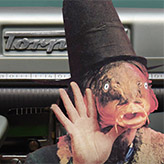
- beak
- Key Master
 Offline
Offline 
- From: Qld Australia
- Registered: 24-3-2013
- Posts: 929
All the keys truly stuck, and getting worse!
Corona Sterling from about 1940 arrived with slightly sticky keys. OK, been there enough times, so started to flush out the segments as usual. Things seemed fine, and we were typing well, but then next day they were stuck again, and stuck more firmly than before - and all of them now. The only result further flushing of the segment has produced is to stick the keys yet more firmly every time, and now it is almost impossible to move them at all unless using force enough likely to break or bend something.
Have flushed with meths (denatured alcohol), turps, and proprietary de-greaser.
Any assistance appreciated.
Sincerely,
beak.
- Laurenz van Gaalen
- Speed Champion
 Offline
Offline 
- From: The Netherlands
- Registered: 20-7-2019
- Posts: 417
Re: All the keys truly stuck, and getting worse!
Try white spirit. If that doesn't help, try paint thinner. If that doesn't help, remove one typebar to check what is going on. I had the same once, and after I removed a typebar I discovered a layer of hardened gunk on the sides of the typebar. The gunk was so hard that I needed to sand it away.
- mikeytap
- Speed Champion
 Offline
Offline 
- From: Georgia, USA
- Registered: 25-12-2021
- Posts: 346
Re: All the keys truly stuck, and getting worse!
beak wrote:
Corona Sterling from about 1940 arrived with slightly sticky keys. OK, been there enough times, so started to flush out the segments as usual. Things seemed fine, and we were typing well, but then next day they were stuck again, and stuck more firmly than before - and all of them now. The only result further flushing of the segment has produced is to stick the keys yet more firmly every time, and now it is almost impossible to move them at all unless using force enough likely to break or bend something.
Have flushed with meths (denatured alcohol), turps, and proprietary de-greaser.
Any assistance appreciated.
I have experienced that same thing with Smith Coronas, you clean it and the next day it has dried and is stuck again.
here is my procedure.
- drip in a few drops of lacquer thinner (do not get any on painted surfaces), let sit a minute.
- type the key madly
- drip in some more and then blow out with compressed air
- repeat
- Lube lightly with Nu-Trol 401B Control Cleaner, this is a very light lube spray.
- Be kind
- thetypewriterman
- Key Master
 Offline
Offline - From: Leiston, England
- Registered: 29-5-2013
- Posts: 942
Re: All the keys truly stuck, and getting worse!
It is possible that some misguided soul thought that it was a good idea to spray the segment with 'Waxoyl' (a paraffin wax-based anti-rust coating that is fine for garden tools before you put them away for the winter but not the thing to use on typewriters) 'Waxoyl' is probably available in other countries, but maybe under a different trade name. It you cannot free the typebars any other way, take them out and soak them in petrol (gasoline), then scrub them. Clean the segment slots with petrol or acetone, making absolutely certain that it doesn't reach any plastic parts, then reassemble and lubricate very sparingly with sewing machine oil. See if that works.![]()
- beak
- Key Master
 Offline
Offline 
- From: Qld Australia
- Registered: 24-3-2013
- Posts: 929
Re: All the keys truly stuck, and getting worse!
Thanks to all.
Have made some progress with lacquer thinners! Am now getting a flow of liquid orange-brown gunk from the lower segment (where the type-bars hinge from) but it still dries out overnight. I think I have to get a small compressor and blow the stuff out while it is still liquid immediately after applying the thinners, so that it is expelled before it gets the chance to set up again.
This is a 6 CPI machine, so worth rescuing, I think.
Sincerely,
beak.
- •
- mikeytap
- Speed Champion
 Offline
Offline 
- From: Georgia, USA
- Registered: 25-12-2021
- Posts: 346
Re: All the keys truly stuck, and getting worse!
beak wrote:
Thanks to all.
Have made some progress with lacquer thinners! Am now getting a flow of liquid orange-brown gunk from the lower segment (where the type-bars hinge from) but it still dries out overnight. I think I have to get a small compressor and blow the stuff out while it is still liquid immediately after applying the thinners, so that it is expelled before it gets the chance to set up again.
This is a 6 CPI machine, so worth rescuing, I think.
I've used canned air successfully if you don't want to got the trouble of setting up a compressor.
- Be kind
- beak
- Key Master
 Offline
Offline 
- From: Qld Australia
- Registered: 24-3-2013
- Posts: 929
Re: All the keys truly stuck, and getting worse!
May try that, but here in Australia canned air is madly expensive, IMO. Going to see how much a small hobby compressor is - have other uses for it anyway.
I know that air pressure (PSI) is something to be careful with - too high can blow springs etc. off their mounts.
Sincerely,
beak.
- •
- Pete E.
- Typewriter Talk Elite
 Offline
Offline 
- From: Idaho - USA
- Registered: 23-6-2020
- Posts: 2,537
Re: All the keys truly stuck, and getting worse!
Beak,
I told my wife a small air compressor in the garage would help me keep the tires on our vehicles properly inflated.
I hand-wash our vehicles and each time I check and top-off the tire pressure and check all fluids.
First time she saw me with a typewriter and the air compressor, she winked at me and said " tire pressure huh ? "
p.s. And here in the States, canned-air makers are required to add a bittering agent into the compressed air...so young kids are not tempted to sniff the stuff in paper bags. Leaves that bittering agent on the typewriter when it dries and onto your hands.
.
.
- CoronaJoe
- Touch Typist
 Offline
Offline 
- Registered: 24-1-2016
- Posts: 145
Re: All the keys truly stuck, and getting worse!
I had one like yours, and it took days to get the stickies out. Now read "carefully". WD40 may help for a solvent action, then follow by mineral spirits to get the WD 40 removed. This is especially helpful if WD40 was used in the past. Alcohol is no help here. Personally I also use Hoppe's No. 9 firearm solvent, as it's a mix of all the good stuff plus the "cologne" smell. Each day the Smith got better, but after a few days there was always "that one" that stuck. But rinse and repeat, rinse and repeat. Eventually it's back to new even after months of setting.
- beak
- Key Master
 Offline
Offline 
- From: Qld Australia
- Registered: 24-3-2013
- Posts: 929
Re: All the keys truly stuck, and getting worse!
Well, eventually it came right! Must have flushed those segments thirty times or more. The Lacquer thinners did the job, but only when combined with air to blow the dried grease or oil (or whatever it was) out WHILE it was still liquid through the action of the thinners. Used a very light spray of silicone oil, which worked additional wonders. I now have 6 CPI available again!
Sincerely,
beak.
- •

 1
1 